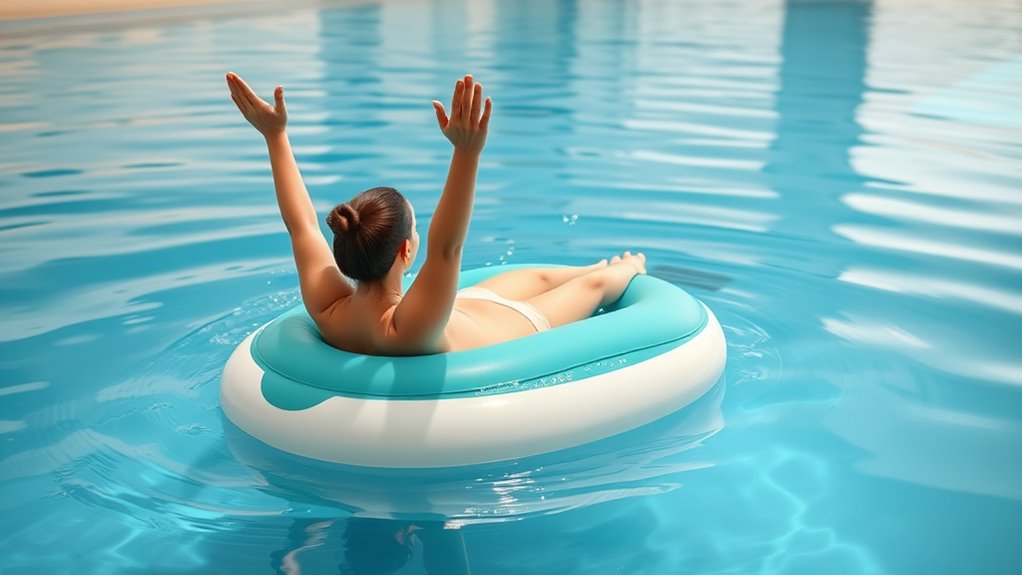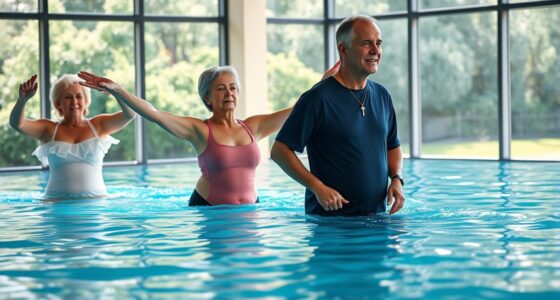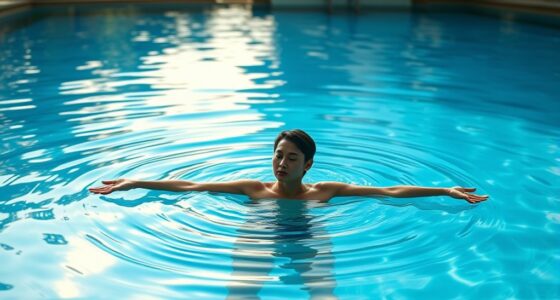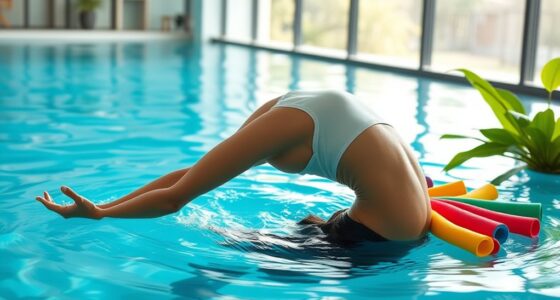Swimming helps your recovery by combining gentle, low-impact movement with water’s natural resistance to build strength without stressing your joints. It eases muscle tension through buoyancy and promotes relaxation, which can reduce pain and stiffness. Water’s soothing effects improve circulation and deliver nutrients to damaged tissues, speeding healing. Plus, it boosts your confidence and motivation during rehab. Keep exploring to discover how water can become a powerful ally in your injury recovery journey.
Key Takeaways
- Water resistance helps gradually strengthen muscles around injured areas without overexertion.
- Buoyancy reduces joint and muscle stress, easing pain and promoting relaxation during recovery.
- Swimming enhances circulation, delivering nutrients and oxygen essential for tissue healing.
- Low-impact water activities improve mobility and confidence while preventing re-injury.
- The calming properties of water reduce stress, supporting overall physical and mental healing.
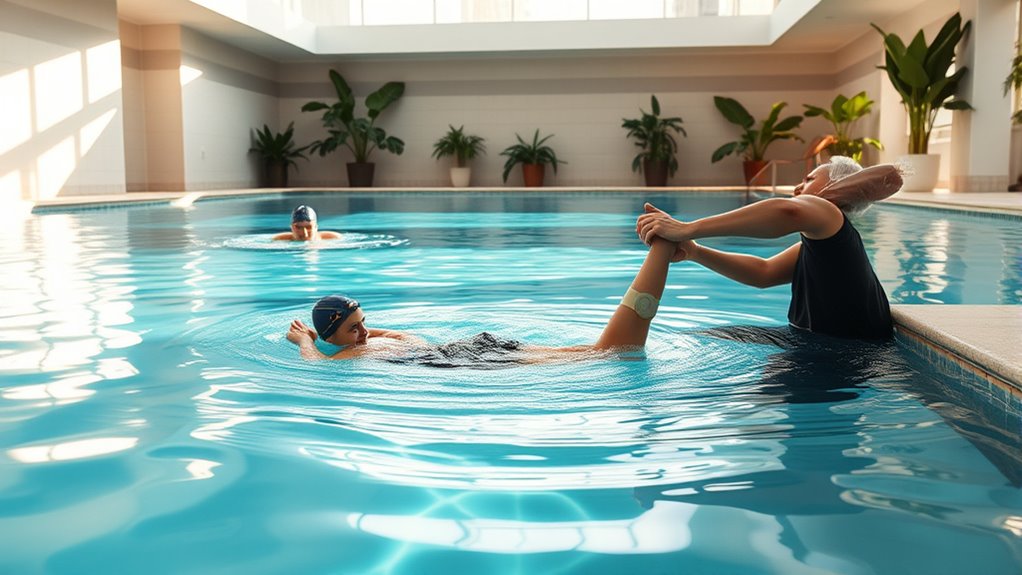
Healing waters have long been celebrated for their ability to restore both body and mind. When you immerse yourself in water, you tap into a natural, gentle way to ease pain and promote recovery. One of the key benefits of swimming during injury recovery is water resistance. Unlike traditional exercise, where gravity and impact can strain healing tissues, water provides a supportive environment that reduces stress on your joints and muscles. This resistance isn’t a barrier; it’s a tool that helps you build strength without overexerting yourself. As you move through the water, every stroke and kick works against resistance, gradually strengthening muscles around injured areas and improving circulation. This process encourages healing and helps prevent further deterioration.
Beyond resistance, water’s soothing properties promote muscle relaxation. When you swim, the buoyant nature of water takes weight off your body, easing tension in stiff or sore muscles. This buoyancy allows you to perform gentle movements that might be painful or impossible on land. As your muscles relax in the water, you experience less pain and stiffness, making it easier to perform rehabilitative exercises. The calming effect of water also reduces stress levels, which can be beneficial for overall recovery. When muscles are relaxed, blood flow increases, delivering essential nutrients and oxygen to damaged tissues, speeding up the healing process.
Water’s soothing buoyancy relaxes muscles, reduces pain, and enhances healing during injury recovery.
Swimming is particularly effective because it combines low-impact activity with the ability to target specific muscle groups. Whether you’re doing gentle laps, water walking, or specific stretches, you control the intensity based on your comfort level. This adaptability is fundamental during injury recovery, as pushing too hard can hinder progress, while moving too little can cause stiffness to set in. Water resistance ensures that even light movements are beneficial, helping you gradually rebuild strength without risking re-injury.
Moreover, engaging in water-based therapy can boost your confidence as you regain mobility. The supportive environment encourages you to move more freely, which can be a significant mental boost during a challenging recovery period. As you progress, you’ll notice increased flexibility, better muscle tone, and less pain, all thanks to the combination of resistance training and muscle relaxation facilitated by the water. Overall, swimming offers a safe, effective way to support your body’s natural healing processes while making recovery more comfortable and sustainable.
Frequently Asked Questions
Can Swimming Help With Chronic Pain Management?
Swimming can definitely help with chronic pain management. It improves your aquatic flexibility, allowing you to move more freely and comfortably. The gentle, weightless environment offers pain relief techniques that reduce stress on your joints and muscles. Regularly engaging in aquatic activities can decrease pain levels, enhance mobility, and boost your overall well-being. So, if you’re seeking a natural way to manage chronic pain, swimming might be an effective option for you.
What Types of Injuries Benefit Most From Aquatic Therapy?
You’ll find that aquatic therapy benefits various injuries, especially those involving joints, tendons, and muscles. Water resistance provides gentle yet effective resistance, helping you build strength without overloading your body. It’s particularly helpful for muscle strengthening and improving flexibility. If you’re recovering from sports injuries, arthritis, or post-surgical issues, aquatic therapy can accelerate healing and reduce pain, making your recovery smoother and safer.
Is Swimming Suitable for Elderly Injury Recovery?
Imagine a gentle river guiding you toward strength; swimming is perfect for elderly injury recovery. It boosts your stamina without stressing joints, thanks to buoyancy and controlled water temperature. You can gradually rebuild muscle and flexibility, feeling safe and supported. Swimming’s low-impact nature makes it ideal, helping you regain independence, reduce pain, and enjoy a calming, therapeutic experience tailored to your needs.
How Often Should One Swim for Optimal Healing?
You should swim 3 to 4 times a week to support ideal healing. Incorporate interval training to gradually increase intensity without overexerting, and take advantage of water resistance to strengthen muscles gently. This approach helps improve circulation, reduce swelling, and promote recovery. Remember to listen to your body and consult your healthcare provider for tailored advice, ensuring your swimming routine supports your injury healing process effectively.
Are There Risks of Re-Injury While Swimming?
Imagine swimming as a gentle dance with water, but risks of re-injury can trip you up. To stay safe, you need to practice risk management and follow safety precautions diligently. Listen to your body, avoid pushing too hard too soon, and stick to your rehab plan. With careful steps, you can glide through recovery without setbacks, turning water’s healing power into a safe, soothing journey.
Conclusion
As you immerse yourself in healing waters, you become a traveler guided by gentle currents, each stroke washing away pain like dawn dispels darkness. Swimming transforms your recovery into a graceful dance with nature’s own remedy, where water’s embrace nurtures your body and spirit. Embrace this liquid sanctuary, and let its soothing tides carry you toward renewal. With every splash, you step closer to reclaiming strength, rediscovering resilience hidden within the calming depths.

